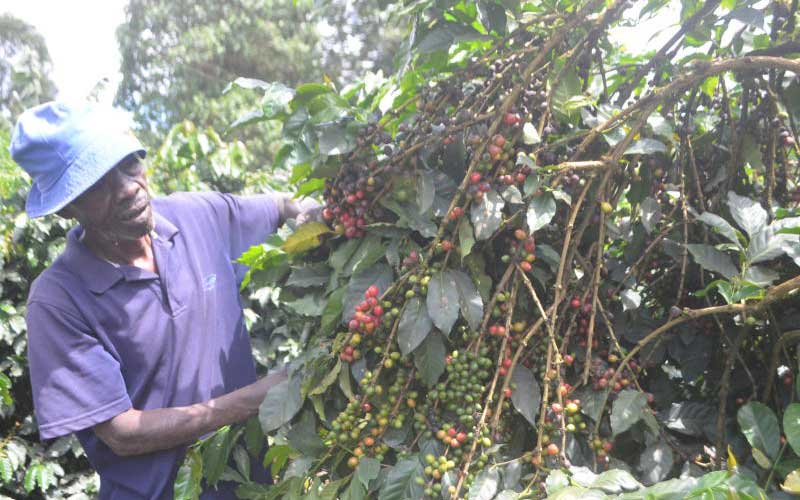Common diseases affecting coffee farms in Kenya pose significant challenges to the production, quality, and profitability of coffee. These diseases primarily affect coffee berries, leaves, and roots and can cause considerable yield losses if left unmanaged. Below is a detailed overview of the most common coffee diseases found in Kenyan coffee farms, their symptoms, impact, and effective management strategies.
1. Coffee Berry Disease (CBD)
Coffee Berry Disease is caused by the fungus *Colletotrichum kahawae*. It primarily attacks developing coffee cherries, causing black lesions on the berries, premature fruit drop, and rotting. CBD is most prevalent in cool, wet conditions, especially during flowering and early fruit development stages. This disease is a major cause of yield reduction among Arabica coffee farmers in Kenya.
Symptoms:
– Brown to black sunken lesions on developing coffee cherries
– Premature dropping of infected berries
– Loss of cherries leading to decreased yields
Management:
– Use of disease-resistant varieties such as Ruiru 11 and Batian
– Proper spacing and pruning of coffee trees to enhance airflow and reduce humidity
– Timely removal and destruction of infected berries
– Application of fungicides where appropriate
2. Coffee Leaf Rust (CLR)
Coffee Leaf Rust, caused by the fungus *Hemileia vastatrix*, is one of the most destructive foliar diseases of coffee. It manifests as yellow-orange powdery spores on the undersides of leaves, leading to defoliation, reduced photosynthesis, and ultimately, diminished coffee yields.
Symptoms:
– Yellow-orange rust-colored spots on leaf undersides
– Premature leaf drop and thinning canopy
– Stunted growth and lower yields
Management:
– Growing resistant coffee varieties
– Pruning coffee trees to improve sunlight penetration and air circulation
– Regular fungicide sprays with copper-based formulations
– Monitoring and early detection
3. Coffee Wilt Disease (CWD)
Coffee Wilt Disease, caused by the fungus *Gibberella xylarioides*, is a vascular disease that blocks water and nutrient transport within coffee plants, leading to wilting and death. It mostly affects Arabica and Robusta coffee trees and has led to severe losses in Kenyan coffee farms.
Symptoms:
– Wilting and drying of leaves and branches
– Premature fruit drop
– Black streaks visible inside the stem when cut open
Management:
– Removal and burning of infected trees to prevent spread
– Use of resistant coffee varieties
– Quarantine and proper sanitation measures in coffee farms
4. Root-Knot Nematodes
Root-knot nematodes are microscopic worms that infest coffee roots, causing galls or knots and interfering with water and nutrient uptake, which leads to stunted growth and poor yields.
Symptoms:
– Galls on roots causing root deformation
– Wilting and stunted plant growth
– Yellowing of leaves due to nutrient deficiency
Management:
– Crop rotation with non-host plants
– Use of resistant rootstocks
– Soil solarization and organic soil amendments for nematode suppression
5. Antestia Bugs (Stink Bugs)
Though technically pests, Antestia bugs (*Antestiopsis spp.*) cause damage similar to diseases by feeding on coffee cherries and transmitting Coffee Wilt Disease bacteria. Their feeding results in blackened ‘sip’ marks on berries and reduces coffee quality.
Symptoms:
– Black lesions on coffee cherries known as black sip
– Off-flavors in coffee due to feeding damage
– Transmitting coffee wilt bacteria
Management:
– Regular monitoring and trapping
– Use of natural predators through integrated pest management
– Maintaining farm hygiene and pruning
Other Common Pests and Diseases:
– Aphids: Sap-sucking pests that weaken plants and promote sooty mold.
– Mealybugs: Cause leaf damage and encourage fungal growth.
– Dieback Disease (Phoma spp.): Causes wilting and death of branches.
Integrated Disease Management Strategies
– Grow disease-resistant coffee varieties like Ruiru 11 and Batian which have been developed for resilience against coffee berry disease and leaf rust.
– Implement good agronomic practices such as proper pruning, spacing, and maintaining farm hygiene.
– Monitor farms regularly to detect early disease symptoms.
– Employ biological controls and encourage natural predators.
– Apply fungicides judiciously and follow recommended guidelines to avoid resistance build-up.
– Enhance soil health and drainage to reduce disease incidence.
Conclusion
Common coffee diseases like Coffee Berry Disease and Coffee Leaf Rust continue to threaten the sustainability and profitability of Kenyan coffee farming. However, with informed management using resistant varieties, cultural practices, and integrated disease control, Kenyan farmers can mitigate these impacts. Continued research, farmer training, and access to disease management inputs remain vital for safeguarding Kenya’s coffee sector and ensuring consistent, high-quality coffee production.

